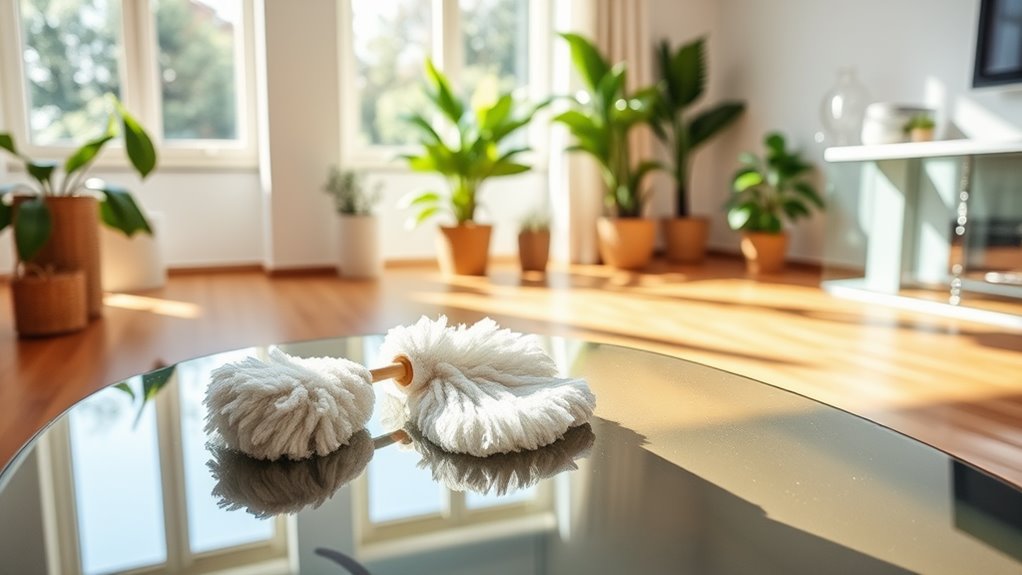Dust Doesn’t Stand a Chance With This 5-Minute Routine
Did you know that the average home collects about 40 pounds of dust each year? You’re likely battling this invisible foe daily, but don’t worry—there’s a smarter way to keep it at bay. With a quick 5-minute routine, you can transform your space into a dust-free zone. Stick around to uncover a step-by-step method that’s efficient and tailored for busy lives like yours.
Key Takeaways
- Start with high surfaces like ceiling fans using a duster to prevent dust from falling lower.
- Use a microfiber cloth for shelves and tables to trap dust effectively.
- Target hidden spots under furniture with an extendable duster for thorough cleaning.
- Wipe electronics gently with a dry microfiber cloth after powering off devices.
- Finish with a quick glide over high-traffic areas for a dust-free space.
Gather Your Dusting Tools
Before you start your 5-minute dust routine, grab the essential tools to make the process quick and effective.
You’ll need a microfiber cloth for trapping dust, a duster with an extendable handle for tricky spots, and a small handheld vacuum for quick cleanups.
Keep a lint-free cloth handy for delicate items.
Store these in a caddy or nearby spot for easy access during your dusting daily routine.
Don’t waste time searching—have everything ready to go.
With these tools, you’ll tackle dust efficiently, ensuring a spotless space in just minutes.
Preparation’s key to making dusting fast and frustration-free.
These items are vital for maintaining a cleaner and healthier home environment.
Start With High Surfaces
Kick off your 5-minute dust routine by tackling high surfaces first.
Dust settles from top to bottom, so starting high prevents it from falling onto already cleaned areas.
Grab your microfiber cloth or duster with an extendable handle and get to work swiftly.
Focus on these key spots:
- Ceiling fan blades – Wipe each blade carefully to remove thick dust buildup.
- Top of cabinets – Clear hidden grime with a quick swipe.
- Light fixtures – Gently dust to avoid streaks or damage.
- Curtain rods – Skim over rods for a polished look.
Stay efficient and keep moving!
This quick daily habit ensures a dust-free home with minimal effort.
Move to Eye-Level Areas
After tackling high surfaces, shift your focus to eye-level areas where dust often hides in plain sight.
Start by scanning high shelves first, using a microfiber cloth to catch every speck, then check window sills daily since they attract dirt from outside.
Don’t skip inspecting tabletop surfaces regularly, as they’re prone to collecting dust from daily use.
This quick routine also prevents dust buildup, ensuring less effort in future cleaning sessions.
Scan High Shelves First
Start your dusting routine by tackling the high shelves first, where dust often accumulates unnoticed.
These elevated spots are out of sight, so they’re easy to miss, but they collect grime fast.
Grab a microfiber cloth or duster with an extendable handle to reach every corner efficiently.
Here’s how to visualize the process:
- Stretch up to swipe along bookshelf tops, clearing gray dust layers.
- Check decor like picture frames for hidden buildup.
- Wipe edges of ceiling fans or light fixtures carefully.
- Scan for cobwebs in high corners with a keen eye.
Stay thorough, and you’ll prevent dust from settling lower.
Check Window Sills Daily
Regularly inspect your window sills each day as you shift focus to eye-level areas during your dusting routine.
These spots collect dust, pollen, and tiny debris fast, especially if windows are open often.
Grab a microfiber cloth or duster and swipe across each sill with precision, ensuring you reach into corners where buildup hides.
Check for smudges or sticky residue too; a quick wipe with a damp cloth can tackle those.
This daily habit prevents dust from settling in and keeps your home looking pristine.
You’ll notice the difference in air quality and cleanliness with just seconds of effort.
Inspect Tabletop Surfaces Regularly
Often, tabletop surfaces at eye level sneakily gather dust and grime, demanding your attention during the 5-minute routine.
You’ve gotta tackle these spots with precision to keep your space spotless.
Grab a microfiber cloth and get to work on shelves, desks, and counters where dust settles fast.
Inspect these areas closely with this checklist:
- Shelves: Wipe off books and decor where dust hides.
- Desks: Clear papers and swipe across the surface.
- Countertops: Target edges where crumbs collect.
- Media Stands: Dust around electronics and cables.
Stay consistent, and you’ll keep grime at bay effortlessly.
Tackle Lower Spots
Grab your dust cloth and focus on the lower spots in your home, like baseboards, floor corners, and under furniture, where dust loves to settle unnoticed. These areas trap allergens fast, so don’t skip ‘em. Crouch down and wipe baseboards with firm, quick strokes. Slide your cloth under furniture to snag hidden dust bunnies. For an even easier approach, try using a dryer sheet to clean baseboards effectively, as it picks up dust with minimal effort.
Use this guide to prioritize:
| Area | Tool | Frequency |
|---|---|---|
| Baseboards | Dust Cloth | Weekly |
| Floor Corners | Microfiber Mop | Biweekly |
| Under Furniture | Extendable Duster | Weekly |
| Low Shelves | Damp Cloth | Biweekly |
Tackle these spots efficiently to keep dust at bay!
Focus on Hidden Corners
Where does dust sneak in without you noticing? It’s those hidden corners of your home that quietly gather grime while you’re busy elsewhere. Don’t let them win! Grab a microfiber cloth or duster with an extendable handle and target these sneaky spots in minutes.
Focus on these often-overlooked areas:
- Behind furniture – Dust bunnies thrive in shadowy gaps.
- Under cabinets – Grit settles where you can’t see.
- Above door frames – Cobwebs lurk out of sight.
- Inside window tracks – Dirt hides in tight grooves.
Attack these spots with precision, and you’ll keep dust at bay effortlessly. Don’t forget to clean baseboards regularly, as they often collect dust and pet hair unnoticed.
Wipe Down Electronics
When tackling electronics in your 5-minute dust routine, always unplug devices before you start to ensure safety.
Grab a microfiber cloth to gently wipe down screens and surfaces, as it traps dust without scratching delicate components.
Don’t use liquid cleaners, since they can damage internal parts or leave unwanted residue.
For a crystal-clear finish, ensure your microfiber cloth is clean and dry before wiping your TV screen.
Unplug Before Cleaning
Before you start wiping down your electronics, make sure to unplug them from any power source to ensure safety and prevent damage.
This crucial step avoids electrical hazards and protects your devices from potential short circuits.
Take a moment to power down and disconnect everything—don’t skip this, as it’s vital for a risk-free cleaning process.
Visualize the setup as you prepare:
- Locate power cords – Spot all cables connected to your device.
- Switch off power – Turn off the device completely.
- Unplug carefully – Gently pull plugs from outlets.
- Secure cords – Move them aside to avoid tripping.
Use Microfiber Cloth
Grab a microfiber cloth to start wiping down your electronics with precision. These cloths attract dust like a magnet, preventing scratches on delicate screens and surfaces. Focus on high-touch areas like keyboards, monitors, and remotes. Use short, firm strokes to trap particles effectively.
Check the table below for targeted wiping strategies:
| Device | Focus Area | Technique |
|---|---|---|
| Smartphone | Screen & Edges | Circular Motions |
| Laptop | Keyboard & Screen | Horizontal Strokes |
| TV Remote | Buttons & Grips | Small, Precise Wipes |
Work systematically, and you’ll keep dust at bay in minutes!
Avoid Liquid Cleaners
Why risk damage with liquid cleaners when wiping down your electronics?
You can keep your devices spotless and safe with a dry approach.
Liquids can seep into sensitive components, causing shorts or corrosion, so stick to a microfiber cloth for effective dusting.
Pay attention to detail and wipe gently to avoid scratches.
Here’s how to do it right:
- Power off your device to prevent accidental inputs.
- Use a dry microfiber cloth to trap dust without residue.
- Target crevices with a soft brush for precision.
- Wipe screens gently to maintain clarity and avoid damage.
Quick Final Sweep
How can you ensure no speck of dust escapes your 5-minute routine?
Wrap up with a quick final sweep to catch any lingering particles.
Grab your microfiber cloth or duster and swiftly glide over high-traffic areas like shelves, tables, and electronics.
Focus on corners and edges where dust hides.
Check under objects for sneaky buildup.
Don’t skip baseboards or window sills—give ‘em a fast swipe.
This last pass, taking just a minute, seals your efforts.
You’ve tackled every surface efficiently, ensuring your space stays pristine.
With this step, dust doesn’t stand a chance in your home!
Using a damp cloth can also help trap dust effectively before it resettles.

